一般现在时1
时态1 一般现在时
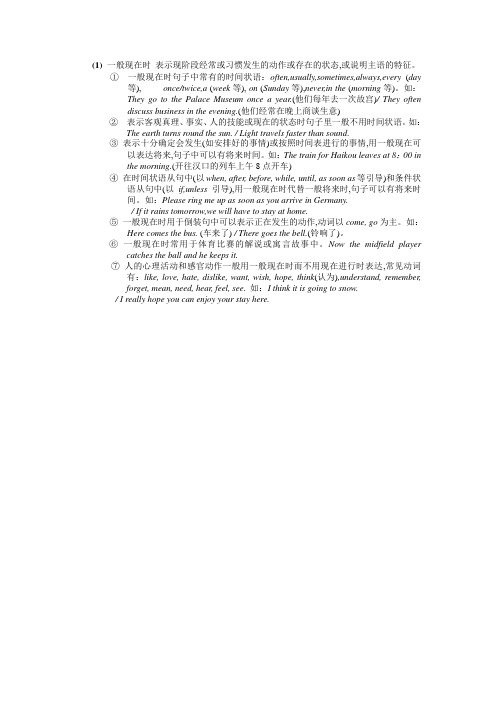
(1)一般现在时表示现阶段经常或习惯发生的动作或存在的状态,或说明主语的特征。
①一般现在时句子中常有的时间状语:often,usually,sometimes,always,every(day等), once/twice,a (week等), on (Sunday等),never,in the (morning等)。
如:They go to the Palace Museum once a year.(他们每年去一次故宫)/ They oftendiscuss business in the evening.(他们经常在晚上商谈生意)②表示客观真理、事实、人的技能或现在的状态时句子里一般不用时间状语。
如:The earth turns round the sun. / Light travels faster than sound.③表示十分确定会发生(如安排好的事情)或按照时间表进行的事情,用一般现在可以表达将来,句子中可以有将来时间。
如:The train for Haikou leaves at 8:00 inthe morning.(开往汉口的列车上午8点开车)④在时间状语从句中(以when, after, before, while, until, as soon as等引导)和条件状语从句中(以if,unless引导),用一般现在时代替一般将来时,句子可以有将来时间。
如:Please ring me up as soon as you arrive in Germany./ If it rains tomorrow,we will have to stay at home.⑤一般现在时用于倒装句中可以表示正在发生的动作,动词以come, go为主。
如:Here comes the bus. (车来了) / There goes the bell.(铃响了)。
⑥一般现在时常用于体育比赛的解说或寓言故事中。
零基础英语语法:一般现在时(1)

美联英语提供:零基础英语语法:一般现在时(1)两分钟做个小测试,看看你的英语水平/test/xiaobai.aspx?tid=16-73675-0一般现在时:经常发生的动作或经常存在的状态。
一般出现下面这样的词就用这个时态,就是说一般现在时常与下列词语连用:always (总是), often(经常), usually(通常), every day/week/month/year/night(每天/每周/每月/每年/每天晚上), sometimes(有时)等等。
I often read English in the morning. 我经常早上读英语。
You watch TV every night. 你每天晚上看电视。
这是经常反复做的动作,所以用一般现在时。
注意:每个句子里,都要有谓语,动词是谓语的主要组成部分。
像句子里的read(读),watch(观看)这些表示动作的词,就是谓语动词。
没有谓语构不成句子。
注意:句子中表示动作的词read和watch就是谓语动词,我们看下面的句子:1.They always play football on Sunday.他们总是星期日踢足球。
2.We go to the zoo every summer holiday.我们每年暑假去动物园。
3.The students usually clean the classrooms after school.学生们通常在放学后打扫教室。
4.He runs on the playground every morning.他每天早晨在操场上跑步。
5.My mother plants flowers every spring.我妈妈每年春天种花。
6.She gets up at 6:00 in the morning.她早上六点钟起床。
大家观察一下这几个句子有什么不同?特别是要看表示动作的动词,看看有什么变化?★英语中的谓语动词发生的时间是通过动词的不同形式来表现的。
小学语法经典总结---一般现在时1
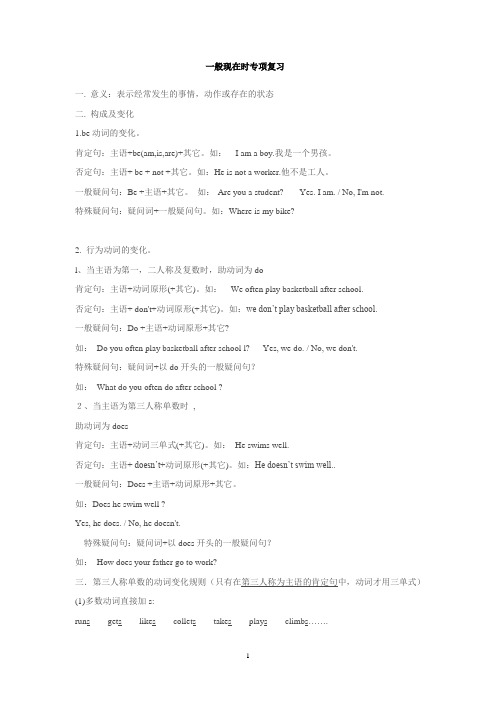
一般现在时专项复习一. 意义:表示经常发生的事情,动作或存在的状态二. 构成及变化1.be动词的变化。
肯定句:主语+be(am,is,are)+其它。
如:I am a boy.我是一个男孩。
否定句:主语+ be + not +其它。
如:He is not a worker.他不是工人。
一般疑问句:Be +主语+其它。
如:-Are you a student? -Yes. I am. / No, I'm not.特殊疑问句:疑问词+一般疑问句。
如:Where is my bike?2. 行为动词的变化。
l、当主语为第一,二人称及复数时,助动词为do肯定句:主语+动词原形(+其它)。
如:We often play basketball after school.否定句:主语+ don't+动词原形(+其它)。
如:we don’t play basketball after school.一般疑问句:Do +主语+动词原形+其它?如:Do you often play basketball after school l? Yes, we do. / No, we don't.特殊疑问句:疑问词+以do开头的一般疑问句?如:What do you often do after school ?2、当主语为第三人称单数时,助动词为does肯定句:主语+动词三单式(+其它)。
如:He swims well.否定句:主语+ doesn’t+动词原形(+其它)。
如:He doesn’t swim well..一般疑问句:Does +主语+动词原形+其它。
如:Does he swim well ?Yes, he does. / No, he doesn't.特殊疑问句:疑问词+以does开头的一般疑问句?如:How does your father go to work?三.第三人称单数的动词变化规则(只有在第三人称为主语的肯定句中,动词才用三单式)(1)多数动词直接加s:runs gets likes collets takes plays climbs…….(2)结尾是s, x, sh, ch, o,前为辅音字母,结尾加es :watches teaches goes does washes crosses mixes brushes(3)动词末尾y前为辅音:将y改为i加es: study→studies fly→fliescarry→carriescry→cries但在y前如果为元音则直接加s:buys says四.时间标志:always , usually , often , sometimes ,every…一般现在时练习一、写出下列动词的第三人称单数形式。
一般现在时的构成1

小学基本语法知识一般现在时的构成1. be动词:主语+be(am,is,are)+其它。
如:I am a boy.我是一个男孩。
He is a student .他是一个学生2.行为动词:主语+行为动词(+其它)。
如:We study English.我们学习英语。
当主语为第三人称单数(he, she,it)时,要在动词后加"-s"或"-es"。
如:Mary likes Chinese.玛丽喜欢汉语。
一般现在时的变化1. be动词的变化。
否定句:主语+ be + not +其它。
如:He is not a worker.他不是工人。
一般疑问句:Be +主语+其它。
如:-Are you a student? -Yes. I am. / No, I'm not. 特殊疑问句:疑问词+一般疑问句。
如:Where is my bike?2.行为动词的变化。
否定句:主语+ don't( doesn't ) +动词原形(+其它)。
如:I don't like bread.当主语为第三人称单数时,要用doesn't构成否定句。
如:He doesn't often play. 一般疑问句:Do( Does ) +主语+动词原形+其它。
如:- Do you often play football?- Yes, I do. / No, I don't.当主语为第三人称单数时,要用does构成一般疑问句。
如:- Does she go to work by bike?- Yes, she does. / No, she doesn't.特殊疑问句:疑问词+一般疑问句。
如:How does your father go to work?当主语为第三人称单数时,要用doesn't构成否定句。
如:He doesn't often play. 一般疑问句:Do( Does ) +主语+动词原形+其它。
1 一般现在时的概念

1.概念:一般现在时表示经常的、习惯性的动作或存在的状态。
2. 一般现在时的构成一般现在时的构成主要有两种形式:(1)be型:句子的谓语动词只有be(am,is或are):a.肯定句中,只出现be,如: I am astudent.我是一名学生。
b.否定句中,要在be后面加not,如:She isn't a teacher.她不是教师。
c.一般疑问句,要将be放在句子开头(注意句首字母大写),句尾用问号,答语用Yes,主语+be.或No,主语+be+not.如:—Areyou ready?—你准备好了吗? —Yes,Iam.—是的,我准备好了。
(—No,I'm not.—不,我没准备好。
)(2)实义动词型:句中的谓语动词为实义动词(也叫行为动词):a.肯定句中,只出现实义动词,如:I getupin themorning.我早晨起床。
b.否定句中,要在实义动词前面加do(does)+not,do(does)作助动词,本身无意义,常与not缩写成don't(doesn't),如:I don't like vegetables.我不喜欢蔬菜。
c.一般疑问句,要在句子开头加助动词Do(does),句尾用问号,简略答语用Yes,主语+do(does).或No,主语+do(does)+not.如:—Doyoulike oranges?—你喜欢桔子吗?—Yes,I do.—是的,我喜欢。
(—No,Idon't.—不,我不喜欢。
)3.一般现在时的用法1) 经常性或习惯性的动作,常与表示频度的时间状语连用,如:every…, sometimes, at…, onSunday等。
I leave homefor school at7every morning. 我每天早上7点去上学。
2) 客观真理,客观存在,科学事实。
The earth moves aroundthe sun.地球绕着太阳。
七年级上册英语一般现在时(1)

一般现在时【概念引入】在英语中,不同时间发生的动作和情况,要用不同的动词形式表示,这种不同的动词形式叫做动词的时态。
今天我们要学习的是一般现在时。
【用法讲解】一、一般现在时的使用范围。
1. 表示现在的状态。
例如:I’m twelve. 我十二岁。
Where’s the schoolbag? 书包在哪里?2. 表示经常或者习惯性的动作。
例如:I have lunch every day. 我每天吃午饭。
Gina always asks: “Where is my schoolbag?”Gina总是问:“我的书包在哪里啊?”3. 表示客观事实或者存在。
例如: My sister is a teacher. 我姐姐是一位老师。
The earth turns around the sun. 地球绕着太阳转。
4. 表示主语所具备的性格和能力。
例如:She likes English very much. 她很喜欢英语。
Bill likes beef, but he doesn’t like chicken.比尔喜欢牛肉但是不喜欢鸡肉。
以上所述均是一般现在时的基本使用范围,除此之外一般现在时还有其他一些特殊用法,比如:一般现在时可以用在一些从句中表将来等,我们会在以后的学习中讲到。
注意:一般现在时态经常与often(经常),sometimes(有时),always(总是),usually(通常)等副词连用,也经常与every day(每天), every week(每周), every month(每月), every term(每学期), every year(每年), once a week(一周一次),twice a year (一年两次)等时间状语连用。
例如:She gets up early every morning. 她每天早上早起。
I go to see my grandmother every month. 我每个月都去看我的奶奶。
小学英语语法专项练习-一般现在时1be动词
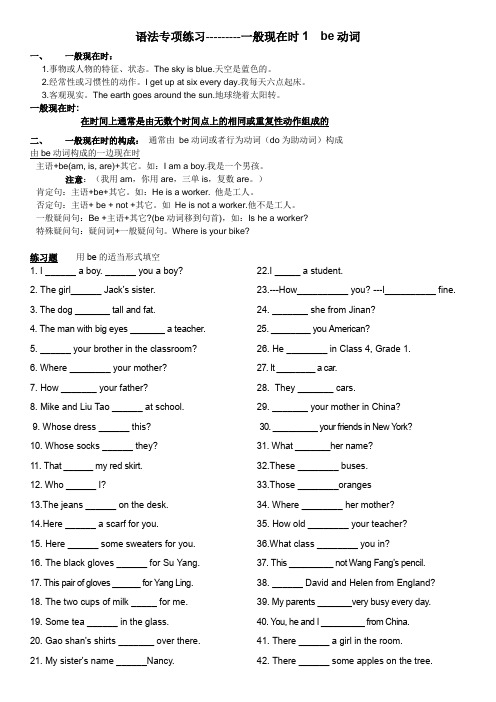
语法专项练习---------一般现在时1 be动词一、一般现在时:1.事物或人物的特征、状态。
The sky is blue.天空是蓝色的。
2.经常性或习惯性的动作。
I get up at six every day.我每天六点起床。
3.客观现实。
The earth goes around the sun.地球绕着太阳转。
一般现在时:在时间上通常是由无数个时间点上的相同或重复性动作组成的二、一般现在时的构成:通常由be动词或者行为动词(do为助动词)构成由be动词构成的一边现在时主语+be(am, is, are)+其它。
如:I am a boy.我是一个男孩。
注意:(我用am,你用are,三单is,复数are。
)肯定句:主语+be+其它。
如:He is a worker. 他是工人。
否定句:主语+ be + not +其它。
如He is not a worker.他不是工人。
一般疑问句:Be +主语+其它?(be动词移到句首),如:Is he a worker?特殊疑问句:疑问词+一般疑问句。
Where is your bike?练习题用be的适当形式填空1. I ______ a boy. ______ you a boy?2. The girl______ Jack's sister.3. The dog _______ tall and fat.4. The man with big eyes _______ a teacher.5. ______ your brother in the classroom?6. Where ________ your mother?7. How _______ your father?8. Mike and Liu Tao ______ at school.9. Whose dress ______ this?10. Whose socks ______ they?11. That ______ my red skirt.12. Who ______ I?13.The jeans ______ on the desk.14.Here ______ a scarf for you.15. Here ______ some sweaters for you.16. The black gloves ______ for Su Yang.17. This pair of gloves ______ for Y ang Ling.18. The two cups of milk _____ for me.19. Some tea ______ in the glass.20. Gao shan's shirts _______ over there.21. My sister's name ______Nancy. 22.I _____ a student.23.---How__________ you? ---I__________ fine.24. _______ she from Jinan?25. ________ you American?26. He ________ in Class 4, Grade 1.27. It ________ a car.28. They _______ cars.29. _______ your mother in China?30. _________ your friends in New Y ork?31. What _______her name?32.These ________ buses.33.Those ________oranges34. Where ________ her mother?35. How old ________ your teacher?36.What class ________ you in?37. This _________ not Wang Fang's pencil.38. ______ David and Helen from England?39. My parents _______very busy every day.40. Y ou, he and I _________ from China.41. There ______ a girl in the room.42. There ______ some apples on the tree.43. _______ there any kites in the classroom?44. _______ there any apple juice in the bottle?45. There _______ some bread on the plate. 46. There _______ a boy, two girls, three men andten women in the park.按要求改写句子1. I am a teacher.否定句:一般疑问句:肯定回答:否定回答: 2. They are new students.否定句:一般疑问句:肯定回答:否定回答:3. He is a good boy at home.否定句:一般疑问句:肯定回答:否定回答:4. We are having an English class.否定句:一般疑问句:肯定回答:否定回答:5. Bob is in Class One, Grade Six.否定句:一般疑问句:肯定回答:否定回答:6. She is form Jinan.否定句:一般疑问句:肯定回答:否定回答:7. We are doing our homework.否定句:一般疑问句:肯定回答:否定回答:8. They are in the teacher’s office.否定句:一般疑问句:肯定回答:否定回答:9. His father is a postman.否定句:一般疑问句:肯定回答:否定回答:10. It is sunny today.否定句:一般疑问句:肯定回答:否定回答:11. They are reading books.否定句:一般疑问句:肯定回答:否定回答:12. His brother is a good- looking boy.否定句:一般疑问句:肯定回答:否定回答:。
六年级英语语法之一般现在时、过去时、将来时,现在进行时

六年级英语语法之⼀般现在时、过去时、将来时,现在进⾏时1. ⼀般现在时(1)⼀般现在时中的be动词:⼀般⽤原形:am is are。
am⽤于第⼀⼈称单数(I);is⽤于第三⼈称单数(he she it和其他⼈名或称谓,如:Ben hissister等);are⽤于第⼆⼈称单数(you)和所有复数(包括第⼀⼈称复数we、第⼆⼈称复数you;第三⼈称复数they和其他复数,如the children 、 his parents等)。
例如:I am a boy 。
She is a good student。
You are the best。
They are aplle,pear and banana。
(2)⼀般现在时中的动词:①主语是第三⼈称单数(he she it 和其他,如Helen 、her cousin 等),动词后⼀般加s或es。
例如:She goes to school from Monday to Friday。
He likes to play basketball。
②主语不是第三⼈称单数,动词都⽤原形。
例如:I like milk。
They do homework together。
注意:⼀般现在时判断依据:①be动词是am、is、are;②动词⽤原形或加s、es;③没有时间状语或有usually、often、everyday、sometimes等不是具体的时间;2、⼀般过去时(1)⼀般过去时中的be动词:⼀般⽤过去式:was werewas⽤于第⼀⼈称单数(I)和第三⼈称单数(he she it和其他⼈名或称谓,如:Ben 、 hissister等);were⽤于第⼆⼈称单数(you)和所有复数(包括第⼀⼈称复数we、第⼆⼈称复数you;第三⼈称复数they和其他复数,如the children 、 his parents等)。
例如:I was at school just now。
一般现在时
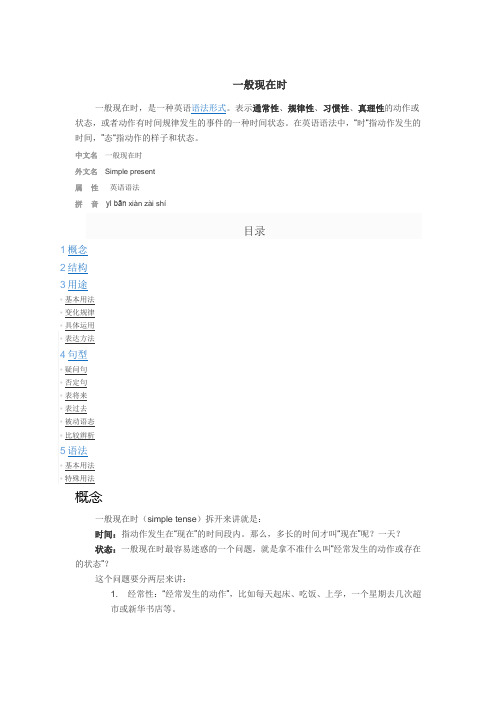
一般现在时一般现在时,是一种英语语法形式。
表示通常性、规律性、习惯性、真理性的动作或状态,或者动作有时间规律发生的事件的一种时间状态。
在英语语法中,“时“指动作发生的时间,”态“指动作的样子和状态。
中文名一般现在时外文名Simple present属性英语语法拼音yì bān xiàn zài shí目录4. 在某些以here,there开头的句子中,用一般现在时表示正在发生的动作。
一般现在时的分析具体运用1. 表示经常的或习惯性的动作,常与表示频率的时间状语连用。
时间状语:always,usually,every morning/night/evening/day/week/year,often,sometimes,occasionally,from time to time,twice a week,rarely,seldom,once a month,hardly,ever,never.e.g. I leave home for school at 7:00 every morning.我每天早上7点左右离开家去学校。
2. 描述主语的状态、性质、特征、能力等,目的是为了“描述现阶段的动作或者状态。
e.g. I don't want so much.我不想要太多。
Wang An writes good English but doesn't speak well.王安英语写得很好但是说的不好比较:Now I put the sugar in the cup.现在我把一些糖放杯子里面。
I am doing my homework now.现在我正在写我的作业。
第一句用一般现在时,用于操作演示或指导说明的示范性动作,表示言行的瞬间动作。
再如:Now watch me,I switch on the current and stand back. 第二句中的now是进行时的标志,表示正在进行的动作的客观状况,所以后句用现在进行时。
一般现在时知识点总结[1]1
![一般现在时知识点总结[1]1](https://img.taocdn.com/s3/m/9b894772443610661ed9ad51f01dc281e43a5656.png)
一般现在时知识点总结一、本次知识点归纳:表达经常性或习惯性的动作、状态、表示真理或客观事实。
二、重要知识点提示:一般现在时需要表示经常性的时间状语例如: always、usually、often、sometimes、everyday、in the morning/afternoon/evening、on Sundays等。
be动词的一般现在时有三种形式, 即: am, is, are(翻译为“是”)1.如果主语是第一人称I(我)时,be动词用am。
如:.a..student.I am 还可缩写成I'm am 与 not 不能缩写。
2.如果主语是you (你, 你们), they (他们, 它们, 她们)或名词复数(两个以上的人或物)时, be动词必须用are如: Are you twelve?are与主语还可缩写。
如: We're, They're, You're。
而are与 not可缩写成aren't3.如果主语是单数名词、不可数名词或第三人称单数代词(he, she, it)时, be动词用is。
如:My mother is a teacher.is也可与主语缩写,如: He's, My mother is = My mother's等。
但是This is不可缩写。
而is与not可缩写成 isn't4.句中含有be动词的陈述句变一般疑问句。
把be动词提到句首, be动词要变大写。
注意第一人称变第二人称。
回答时用yes或no表示, 结构: Yes, 主语+be动词, No, 主语+be动词+not。
5.句中含有be动词的肯定陈述句变否定句。
先找肯定陈述句中的be动词, 在be动词后加not.根据以上叙述我们可以把动词的用法以口诀的形式表述出来:我用am, 你用are, is跟着他(he), 她(she), 它(it);单数名词用is, 复数名词全用are。
1一般现在时
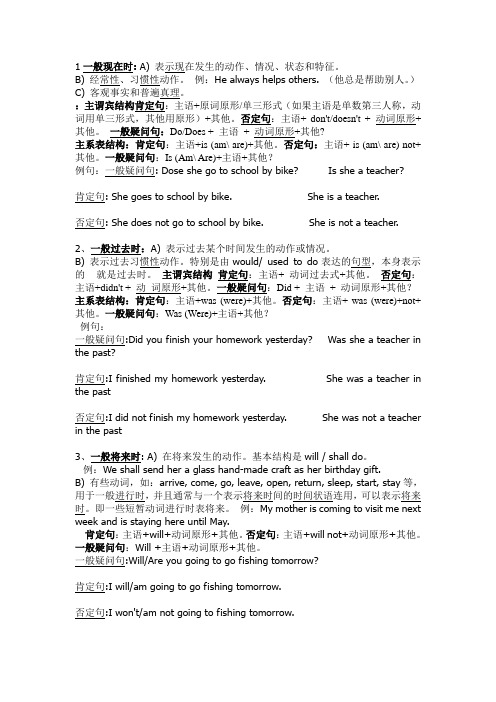
1一般现在时: A) 表示现在发生的动作、情况、状态和特征。
B) 经常性、习惯性动作。
例:He always helps others. (他总是帮助别人。
)C) 客观事实和普遍真理。
:主谓宾结构肯定句:主语+原词原形/单三形式(如果主语是单数第三人称,动词用单三形式,其他用原形)+其他。
否定句:主语+ don't/doesn't + 动词原形+其他。
一般疑问句:Do/Does + 主语+ 动词原形+其他?主系表结构:肯定句:主语+is (am\ are)+其他。
否定句:主语+ is (am\ are) not+其他。
一般疑问句:Is (Am\ Are)+主语+其他?例句:一般疑问句: Dose she go to school by bike? Is she a teacher?肯定句: She goes to school by bike. She is a teacher.否定句: She does not go to school by bike. She is not a teacher.2、一般过去时:A) 表示过去某个时间发生的动作或情况。
B) 表示过去习惯性动作。
特别是由would/ used to do表达的句型,本身表示的就是过去时。
主谓宾结构肯定句:主语+ 动词过去式+其他。
否定句:主语+didn't + 动词原形+其他。
一般疑问句:Did + 主语+ 动词原形+其他?主系表结构:肯定句:主语+was (were)+其他。
否定句:主语+ was (were)+not+其他。
一般疑问句:Was (Were)+主语+其他?例句:一般疑问句:Did you finish your homework yesterday? Was she a teacher in the past?肯定句:I finished my homework yesterday. She was a teacher in the past否定句:I did not finish my homework yesterday. She was not a teacher in the past3、一般将来时: A) 在将来发生的动作。
一般现在时(1)

1、当句子表状态说明主语是什么或怎么样时,其句型:主+BE动词(am, is, are)+表语,否定式是在BE动词后加not,疑问句是将BE动词提前到句首(即在主语之前)The twin sisters are from America. 这对孪生姐妹是美国人。
The twin sisters are not from America.Are the twins from America?2、当谓语由实义动词充当,主语不是第三人称单数时,句子结构为:主语+动词原形+其它否定式为:主语+don't+动词原形+其它疑问句为:Do+主语+动词原形+其它?We speak Chinese.Do you speak Chinese?They don't speak Chinese.当主语是第三人称单数时:句子结构为主语+动词(词尾加s或es)+其它。
否定式为:主语+doesn't+动词原形+其它。
疑问句式:Does+主语+动词原形+其它?1.多数在动词后+s play —plays like —likes(1)直接在动词词尾加-s.ask---asks work---works get---gets stay---stays(2)以字母s, x, ch, sh或o结尾的动词,在词尾直接加-es.watch---watches wish---wishes fix---fixes do---doesgo---goes pass---passes(3)以“辅音字母加- y”结尾的动词,要先变y为i再加-es.try---tries study---studies cry---cries fly---flies情况构成方法读音例词一般情况加-s清辅音后读/s/ 浊辅音和元音后读/z/ swim-swims;help-helps;like-likes以辅音字母+o结尾的词加-es 读/z/ goes,does以s,sh,ch,x等结尾的词加-es 读/iz/ watches,washes 以辅音字母+y结尾的词变y 为i再加es 读/z/ study-studies不规则变化have和be 动词变have 为has变be为am,is,arehave-has be-am,is,are当主语是第三人称单数时:1、动词变相对应的第三人称单数形式2、肯定句主语+动词s+其它3、否定句主语+doesn't+动词原形+其它4、一般疑问句Does+主语+动词原形+其它5、肯定回答Yes,主语+does6、否定回答No,主语+doesn't7、特殊疑问句特殊疑问词+一般疑问句当主语不是第三人称单数时:1、肯定句主语+动词原形+其它2、否定句主语+don't+动词原形+其它3、一般疑问句Do+主语+动词原形+其它4、要注意,句式结构错则全都错。
动词的时态一般现在时与一般过去时一般现在时一

was/were doing sth. when...did sth. 主语正在做某事,这时突然…… was/were about to do sth...when...did sth. 3.主语+ 主语正要做某事,这时突然…… had done sth. ...when...did sth. 主语做了某事,这时突然……
3.过去完成时为“过去的过去”,因而过去完成时必须以过 去的某个时间点为参照点,句中往往有表示过去的时间 状语或状语从句,也可以是上下文的暗示。 I happened to meet an old friend in the hotel yesterday. We had not seen each other for years.我昨天碰巧在旅店 遇到一位老朋友。我们已经有多年没有见面了。
Many people had arrived at the square long before the sun rose early in the morning. 一大早在日出之前许多人就已经来到了广场。 By the time they were rescued, they had been buried in the ruins for nearly a week.到他们获救时,他们已经被 埋在废墟中将近一周的时间了。 It was the last time that he had seen his parents. 那是他最后一次看到他的父母。
They were making a trip to a famous attraction when the car broke down. 他们正去一个著名的景点旅行,这时车突然坏了。 The girl had traveled a very short distance when she found herself driving in the wrong direction. 女孩开车不远,这时突然发现自己开错了方向。
一般现在时1
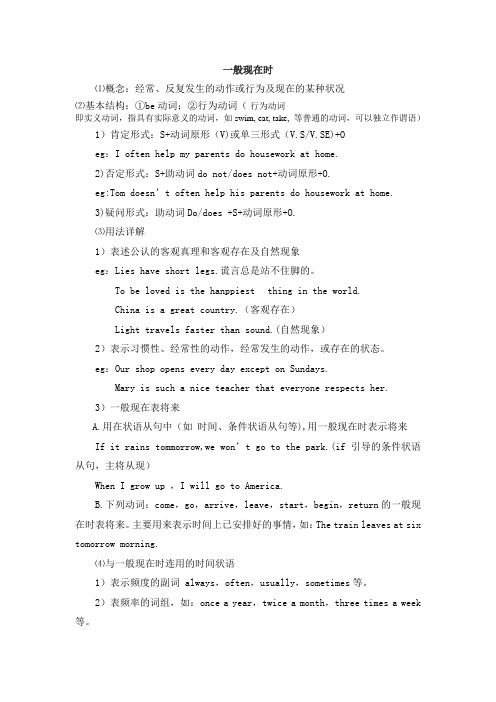
一般现在时⑴概念:经常、反复发生的动作或行为及现在的某种状况⑵基本结构:①be动词;②行为动词(·行为动词即实义动词,指具有实际意义的动词,如swim, eat, take, 等普通的动词,可以独立作谓语) 1)肯定形式:S+动词原形(V)或单三形式(V.S/V.SE)+Oeg:I often help my parents do housework at home.2)否定形式:S+助动词do not/does not+动词原形+O.eg:Tom doesn’t often help his parents do housework at home.3)疑问形式:助动词Do/does +S+动词原形+O.⑶用法详解1)表述公认的客观真理和客观存在及自然现象eg:Lies have short legs.谎言总是站不住脚的。
To be loved is the hanppiest thing in the world.China is a great country.(客观存在)Light travels faster than sound.(自然现象)2)表示习惯性、经常性的动作,经常发生的动作,或存在的状态。
eg:Our shop opens every day except on Sundays.Mary is such a nice teacher that everyone respects her.3)一般现在表将来A.用在状语从句中(如时间、条件状语从句等),用一般现在时表示将来If it rains tommorrow,we won’t go to the park.(if引导的条件状语从句,主将从现)When I grow up ,I will go to America.B.下列动词:come,go,arrive,leave,start,begin,return的一般现在时表将来。
一般现在时(1)

• • • •
Her hands are wet. Her hands are not wet . My car is broken. My car is not broken.
• • • • • • • •
他们不是学生。 They are not students. 刘飞不是跑步运动员。 Liu Fei is not a runner. 她的名字不是小丽。 Her name is not Xiao Li. 这个游戏没意思。 This game is not interesting.
主谓宾结构的一般疑问句
• 结构是 助动词do/does+主语+实意动词+ 各类状语? • 把肯定句改为一般疑问句的方法是 • 一加 二改 三问号
助动词do/does
人称或动词原形
句末加?
I get up at 6:35 in the morning.
否定句:
I do ning. Do you get up at 6:35 in the morning? Yes, I do. No, I don’t.
五、相关的句型转换:
1、变否定句:现在进行时态的句子变否定句时,在am/is/are后加 not,常与am/is/are用缩略式。 Eg1. They are singing.----They are not/ aren’t singing. 2、变一般疑问句:现在进行时态的句子变一般疑问句时把 am/is/are提到句首,大小写发生变化,句号变问号。 Eg1. I am doing my homework now.----Are you doing your homework now? Eg2. The students are having classes.----Are the students having classes? 3、划线提问:先确定疑问词,然后把除掉划线部分的句子变成一 般疑问句接在疑问词后面。
1_一般现在时概念
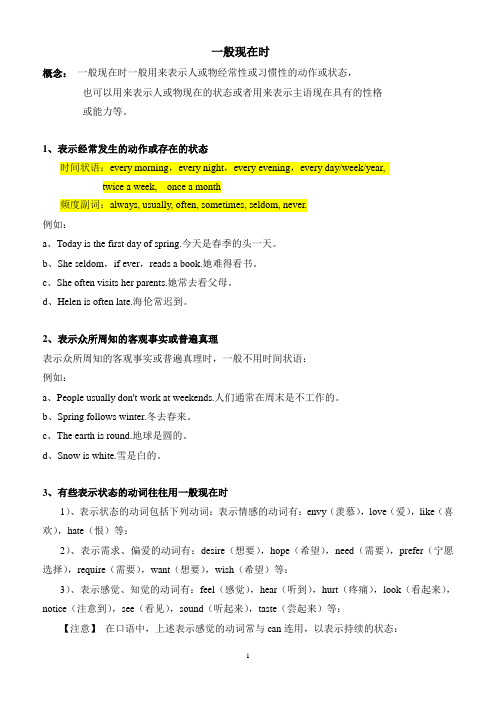
一般现在时概念:一般现在时一般用来表示人或物经常性或习惯性的动作或状态,也可以用来表示人或物现在的状态或者用来表示主语现在具有的性格或能力等。
1、表示经常发生的动作或存在的状态时间状语:every morning,every night,every evening,every day/week/year,twice a week, once a month频度副词:always, usually, often, sometimes, seldom, never.例如:a、Today is the first day of spring.今天是春季的头一天。
b、She seldom,if ever,reads a book.她难得看书。
c、She often visits her parents.她常去看父母。
d、Helen is often late.海伦常迟到。
2、表示众所周知的客观事实或普遍真理表示众所周知的客观事实或普遍真理时,一般不用时间状语:例如:a、People usually don't work at weekends.人们通常在周末是不工作的。
b、Spring follows winter.冬去春来。
c、The earth is round.地球是圆的。
d、Snow is white.雪是白的。
3、有些表示状态的动词往往用一般现在时1)、表示状态的动词包括下列动词:表示情感的动词有:envy(羡慕),love(爱),like(喜欢),hate(恨)等:2)、表示需求、偏爱的动词有:desire(想要),hope(希望),need(需要),prefer(宁愿选择),require(需要),want(想要),wish(希望)等:3)、表示感觉、知觉的动词有:feel(感觉),hear(听到),hurt(疼痛),look(看起来),notice(注意到),see(看见),sound(听起来),taste(尝起来)等:【注意】在口语中,上述表示感觉的动词常与can连用,以表示持续的状态:4)、表示思想、信念的动词有:agree(同意),allow(允许),believe(相信),doubt(怀疑),find(发现),know(知道),guess(猜想),mean(意思是),mind(在意),propose(提议),recognize(认出),remember(记得),suggest(提议),suppose(猜想),think(以为),understand(理解)等:5)、表示存在、外观、拥有、所有的动词有:appear(呈现),be(是),contain(包含),consist(存在于),belong(属于),fit(合适),have(有),matter(要紧、重要),need(需要),owe(拥有),prove(证明),possess(拥有),remain(留下),seem(好像),show(说明),suit(适合)等:4、在时间、条件状语从句中表示将要发生的动作例如:a、Much as I like it,I will not buy it.虽然我很喜欢这东西,但不想买它。
资料:一般现在时(1)
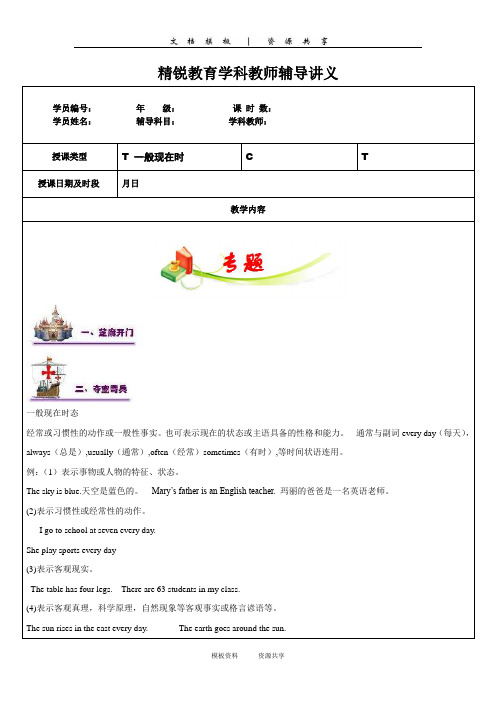
精锐教育学科教师辅导讲义学员编号:年级:课时数:学员姓名:辅导科目:学科教师:授课类型T 一般现在时 C T授课日期及时段月日教学内容一般现在时态经常或习惯性的动作或一般性事实。
也可表示现在的状态或主语具备的性格和能力。
通常与副词every day(每天),always(总是),usually(通常),often(经常)sometimes(有时),等时间状语连用。
例:(1)表示事物或人物的特征、状态。
The sky is blue.天空是蓝色的。
Mary’s father is an English teacher.玛丽的爸爸是一名英语老师。
(2)表示习惯性或经常性的动作。
I go to school at seven every day.She play sports every day(3)表示客观现实。
The table has four legs. There are 63 students in my class.(4)表示客观真理,科学原理,自然现象等客观事实或格言谚语等。
The sun rises in the east every day. The earth goes around the sun.(5)表示平日的喜好I like apples. She doesn’t like vegetables.二、只有主语在第三人称单数时在陈述句里面实义动词用“三单形式”,其他人称(一,二,三复)用动词原形。
e.g. I/ We like English very much. 我/我们非常喜欢英语。
She/ He/His sister likes English very much. 她/他/她的妹妹非常喜欢英语★动词三单形式的变化规则:1.多数直接在动词词尾加-s. play — plays like — likes ask---asks work---works get---getscall---calls2.以字母s, x, ch, sh或o结尾的动词,在词尾直接加-es. watch---watches wash---washes do---does go---goes (3)以“辅音字母加- y”结尾的动词,要先变y为i再加-es. try---tries study---studies cry---criesfly---flies 2.不规则变化:be---- is have----has一般现在时态肯定句式:分为含有be动词和实义动词的两种情况:一.含有be 动词的一般现在时的句式:肯定句式:主语+be+表语( n./adj.等)e.g. ①He is a worker. 他是个老师②You are nine. 你9岁。
小学五年级英语语法时态一般现在时(1)分析
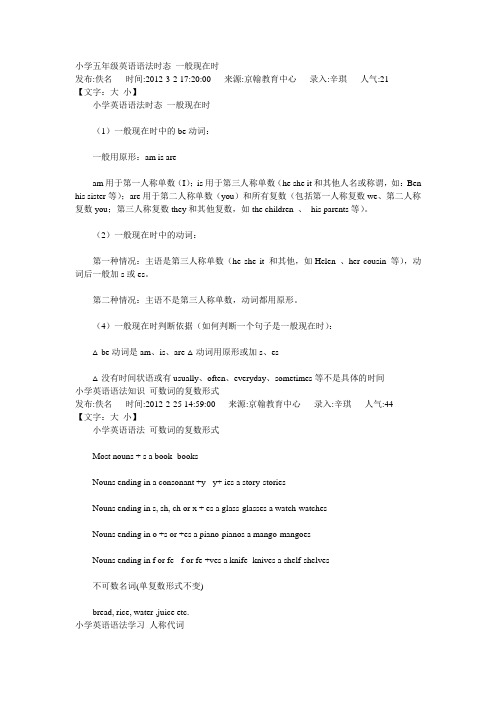
小学五年级英语语法时态一般现在时
发布:佚名时间:2012-3-2 17:20:00来源:京翰教育中心录入:辛琪人气:21
【文字:大小】
小学英语语法时态一般现在时
(1)一般现在时中的be动词:
一般用原形:am is are
7. In his letter, he said that he __________ us very much. (miss)
8. The film __________ for nearly fifteen minutes when I got to the cinema. (be)
9. He said he became __________ in physics. (interest)
发布:佚名时间:2011-12-19 17:30:00来源:京翰教育中心录入:辛琪人气:149
【文字:大小】
小学五年ቤተ መጻሕፍቲ ባይዱ英语语法一般疑问句
如何将一个肯定的陈述句改为一般疑问句:
1、看句中有无be动词,如有,把be动词提到句首即可。
2、看句中有无情态动词,如有,把情态动词提到句首即可。
3、如上述二者都没有,就应把助动提到句首。分四个步骤:
牛津版五年级英语语法练习题一般现在时
发布:佚名时间:2011-12-8 16:59:00来源:京翰教育中心录入:辛琪人气:196
【文字:大小】
牛津版五年级英语语法练习题:一般现在时练习:
一般现在时:表示经常性的事情。
时间状语:often经常, usually通常, always总是,every每个,
情态动词can+ not、
常用时态(1)
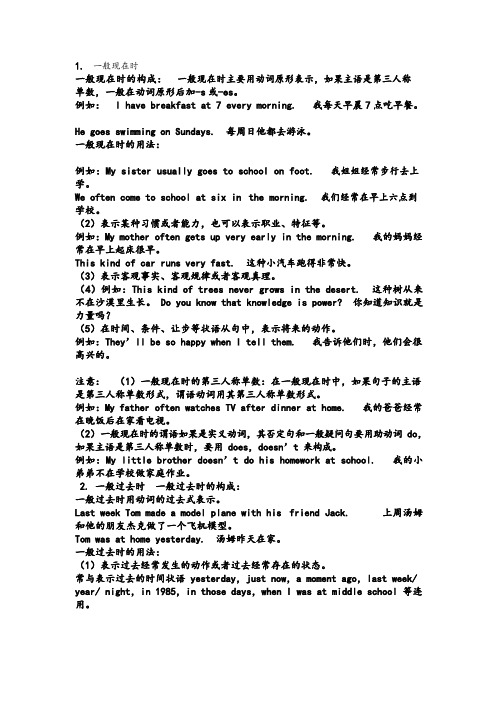
1.一般现在时一般现在时的构成:一般现在时主要用动词原形表示,如果主语是第三人称单数,一般在动词原形后加-s 或-es。
例如:I have breakfast at 7 every morning. 我每天早晨7 点吃早餐。
He goes swimming on Sundays. 每周日他都去游泳。
一般现在时的用法:例如:My sister usually goes to school on foot. 我姐姐经常步行去上学。
We often come to school at six in the morning. 我们经常在早上六点到学校。
(2)表示某种习惯或者能力,也可以表示职业、特征等。
例如:My mother often gets up very early in the morning. 我的妈妈经常在早上起床很早。
This kind of car runs very fast. 这种小汽车跑得非常快。
(3)表示客观事实、客观规律或者客观真理。
(4)例如:This kind of trees never grows in the desert. 这种树从来不在沙漠里生长。
Do you know that knowledge is power? 你知道知识就是力量吗?(5)在时间、条件、让步等状语从句中,表示将来的动作。
例如:They’ll be so happy when I tell them. 我告诉他们时,他们会很高兴的。
注意:(1)一般现在时的第三人称单数:在一般现在时中,如果句子的主语是第三人称单数形式,谓语动词用其第三人称单数形式。
例如:My father often watches TV after dinner at home. 我的爸爸经常在晚饭后在家看电视。
(2)一般现在时的谓语如果是实义动词,其否定句和一般疑问句要用助动词 do,如果主语是第三人称单数时,要用 does,doesn’t来构成。
